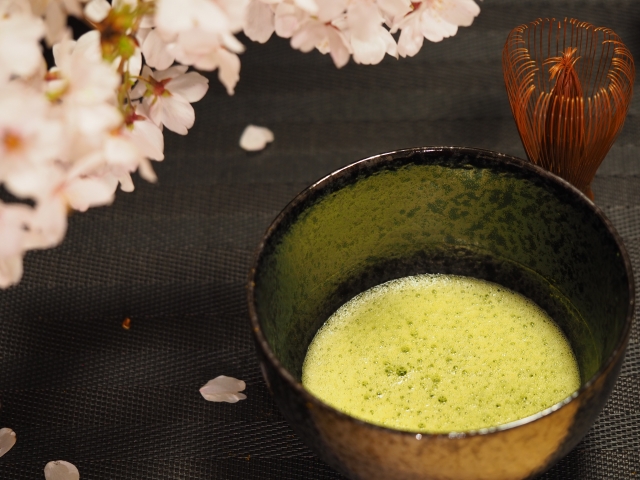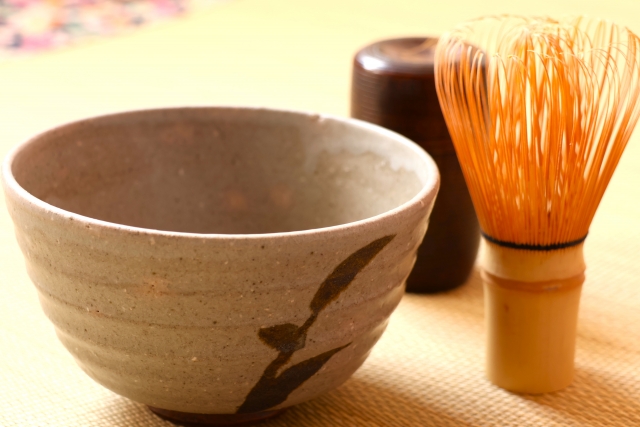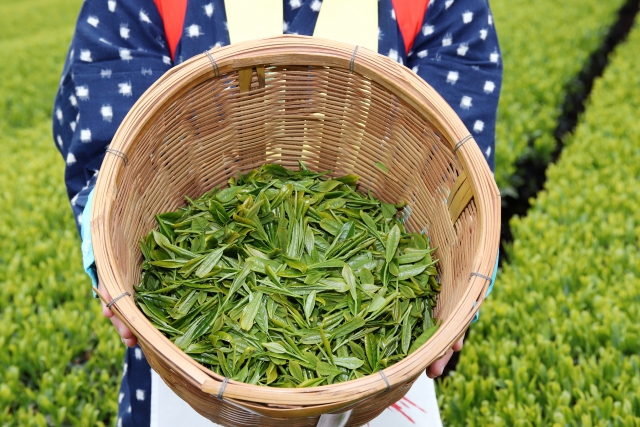
Matcha: A Global Superfood Blending Tradition and Innovation
1. Introduction
Matcha, long cherished in Japanese tea ceremonies, has now captured global attention as a “superfood.” This vibrant green powdered tea has transcended its role as a mere beverage, finding innovative applications in health, beauty, and culinary fields worldwide.
Having evolved from a traditional Japanese drink to a global superfood phenomenon, matcha’s appeal and potential are vast. Let’s explore its allure and possibilities from nutritional, cultural, and practical perspectives.
2. What is Matcha?
Definition and Production Method
Matcha is a finely ground powder made from specially grown and processed green tea leaves. Unlike regular green tea, matcha allows for the consumption of the entire tea leaf.
Difference from Regular Green Tea
While regular green tea involves steeping leaves in hot water, matcha is made by whisking the powder directly into water or milk. This method allows for a significantly higher intake of nutritional components compared to steeped green tea.
History and Cultural Background of Matcha
Matcha’s origins can be traced back to 12th century China, but it was in Japan where its production methods and consumption rituals were refined. Particularly through the development of the tea ceremony, matcha transcended its role as a mere drink to become a cultural symbol embodying Japanese aesthetics and spirituality.
3. Nutritional Profile of Matcha
Matcha contains various nutritional components, with particular emphasis on:
Catechins (especially EGCG)
Catechins, powerful antioxidants abundant in matcha, particularly EGCG (Epigallocatechin Gallate), may contribute to cancer prevention and reduction of heart disease risk.
L-Theanine
This amino acid promotes relaxation while enhancing concentration. L-theanine in matcha works synergistically with caffeine to produce a state of calm alertness.
Caffeine
Moderate amounts of caffeine boost metabolism and improve concentration and endurance. The caffeine in matcha, combined with L-theanine, provides a more gentle and sustained energy boost compared to coffee.
Vitamins (C, A, E, K)
Matcha contains various vitamins, with Vitamin C being crucial for immune function enhancement and Vitamin K playing a vital role in maintaining bone health.
Minerals
Calcium, magnesium, zinc, and other minerals in matcha contribute to overall health maintenance.
Dietary Fiber
The dietary fiber in matcha aids in improving gut health and moderating sugar absorption.
The synergistic effect of these nutritional components is believed to provide health benefits beyond what individual components can offer.
4. Health Benefits of Matcha
The main health benefits expected from matcha consumption include:
Metabolism Boost and Weight Loss Effects
The synergistic effect of catechins and caffeine increases basal metabolism and promotes fat burning. Additionally, dietary fiber helps prevent rapid rises in blood sugar after meals, potentially curbing overeating.
Antioxidant Action and Beauty Benefits
Abundant antioxidants neutralize free radicals that cause skin aging, spots, and wrinkles. Furthermore, Vitamins C and E promote collagen production, contributing to skin elasticity maintenance.
Cardiovascular Health Maintenance
Catechins may prevent the oxidation of LDL cholesterol, reducing the risk of atherosclerosis. They are also said to contribute to blood pressure stabilization.
Brain Function and Cognitive Enhancement
The combination of L-theanine and caffeine has been shown to improve concentration and memory. Long-term matcha consumption has also been linked to reduced risk of cognitive decline in some studies.
Immune System Strengthening
Vitamin C and catechins in matcha can enhance immune function. Catechins, in particular, have antibacterial properties that may help prevent colds and flu.
Stress Reduction and Relaxation Effects
L-theanine has stress-reducing properties and promotes a state of relaxation. It simultaneously enhances concentration, creating a state of calm productivity.
Oral Hygiene Improvement
The antibacterial action of catechins may inhibit the growth of bacteria causing tooth decay and gum disease. It’s also believed to help prevent bad breath.
5. Matcha and Modern Wellness Trends
Matcha aligns well with modern wellness trends and is incorporated in various ways:
Affinity with Mindfulness and Meditation
The act of drinking matcha itself can be a form of meditation or mindfulness practice. Especially, the process of preparing matcha according to tea ceremony traditions provides an excellent opportunity to calm the mind and step away from daily stresses.
Fitness and Exercise Performance Enhancement
The combination of caffeine and L-theanine in matcha provides sustained energy and improved focus, making it a popular pre-workout drink. The antioxidants are also expected to aid in post-exercise recovery.
Role in Plant-Based Diets
Among vegans and vegetarians, matcha is gaining attention as a nutrient-rich plant-based beverage. When combined with plant-based milk rich in calcium and vitamin B12, it becomes an even more nutritionally complete drink.
Application in Beauty and Anti-Aging
The antioxidant properties of matcha are believed to keep skin beautiful from within, leading to increased demand for matcha in beauty drinks and foods. Skincare products incorporating matcha are also on the rise.
6. Diverse Uses of Matcha
The applications of matcha range from traditional consumption methods to modern arrangements:
Traditional Consumption in Tea Ceremonies
Whisking and savoring matcha in the traditional way provides an opportunity to experience the essence of Japanese culture.
Modern Drink Arrangements
- Matcha Latte: A popular drink combining matcha and milk
- Matcha Smoothie: A healthy drink blending matcha and fruits
- Matcha Protein Shake: Popular among fitness enthusiasts
Application in Cuisine and Desserts
- Matcha Ice Cream
- Matcha Cakes and Cookies
- Matcha Soba Noodles
- Matcha Risotto
Utilization in Beauty Products
- Matcha Face Masks
- Matcha Body Scrubs
- Matcha-infused Toners
7. Global Spread of Matcha
The popularity of matcha has spread beyond Japan to the world:
Fusion with Western Café Culture
Matcha lattes and similar menu items have become standard in major coffee chains, deeply penetrating Western café culture.
Examples of Matcha Menu Items Around the World
- USA: Matcha Donuts, Matcha Frappuccinos
- Italy: Matcha Gelato
- France: Matcha Macarons
- Thailand: Matcha Crepes
Growing Interest in Japanese Culture Through Matcha
With the rise in matcha’s popularity, there’s an increase in foreigners interested in tea ceremonies and traditional Japanese culture. Matcha has become an important medium for introducing Japanese culture to the world.
8. Choosing and Quality of Matcha
Selecting high-quality matcha is crucial for maximizing its benefits:
Characteristics of High-Quality Matcha
- Vibrant green color
- Fine powder consistency
- Sweet aroma
- Smooth taste
Importance of Origin and Production Method
Matcha produced in traditional tea regions of Japan (e.g., Uji in Kyoto) is often of high quality. Whether the tea leaves were grown using the shaded cultivation method (covering tea plants to protect them from direct sunlight) is also an important indicator.
Organic and Fair Trade Matcha
There’s an increase in organic matcha grown with environmental considerations and Fair Trade certified matcha ensuring fair profits for producers. These are gaining attention from the perspectives of sustainability and ethical consumption.
9. Proper Consumption Methods and Precautions
To fully enjoy the health benefits of matcha, it’s important to know the proper consumption methods:
Recommended Daily Intake
Generally, consumption of 1-2 cups per day (1-2 grams of matcha per cup) is recommended. However, the appropriate amount may vary depending on individual constitution and purpose.
Potential Risks of Overconsumption
Excessive intake of caffeine in matcha may cause symptoms such as insomnia and gastrointestinal discomfort. Also, as matcha contains components that may inhibit iron absorption, those prone to anemia should be cautious.
Precautions for Specific Health Conditions and During Pregnancy
- Pregnant or breastfeeding women: Need to be cautious about caffeine intake.
- Those with sleep disorders: Should avoid consumption before bedtime.
- Those taking specific medications: It’s recommended to consult a doctor about potential interactions with matcha.
10. Latest Research and Future Prospects
Research on matcha is ongoing, revealing new possibilities:
Latest Scientific Research on Matcha
- Cognitive Function Improvement: Long-term matcha consumption may reduce the risk of dementia.
- Cancer Prevention: Research on the anti-cancer effects of catechins in matcha is progressing.
- Obesity Prevention: The metabolism-boosting effect of matcha may contribute to obesity prevention.
Potential New Health Benefits
Matcha is a special green tea that has evolved from traditional Japanese tea culture into a modern global superfood. Its characteristics and value can be summarized in the following points
- Nutritional Value
- Rich in active ingredients such as catechins (EGCG), L-theanine, and caffeine
- Contains vitamins (C, A, E, K), minerals, and dietary fiber
- Higher nutritional value than regular green tea because whole tea leaves are ingested
- Main Health Benefits
- Metabolism promotion and weight loss effects
- Antioxidant effect for beauty
- Cardiovascular health maintenance
- Improved brain and cognitive function
- Strengthening of the immune system
- Stress reduction effect
- Utilization in modern times
- Compatibility with mindfulness and meditation
- Application in the fitness field
- Application in beauty products
- Expansion into a variety of cuisines and desserts
- Global expansion
- Expansion of menus in various regions of the world
- Fusion with Western café culture
- Role as a medium for transmitting Japanese culture
- Practical Points to Consider
- How to distinguish quality (color, fineness of powder, aroma, taste)
- Appropriate intake (1-2 cups per day)
- Precautions against overconsumption
- Considerations for certain health conditions
Thus, matcha is positioned as a food with multifaceted potential, combining traditional values with modern health and wellness values.
https://greenteatokyo.com/en/matcha-at-home/
1. はじめに
古来より日本の茶道で愛されてきた抹茶が、今や世界中で注目を集める「スーパーフード」として脚光を浴びています。鮮やかな緑色と独特の風味を持つこの粉末状のお茶は、単なる飲み物の枠を超え、健康・美容・料理など多岐にわたる分野で革新的な活用法を見出しています。
伝統的な日本の飲み物から世界的なスーパーフードへと進化を遂げた抹茶。その魅力と可能性について、栄養学的な観点から文化的な側面まで、幅広く探っていきましょう。
2. 抹茶とは何か
定義と製造方法
抹茶とは、特別に栽培された茶葉を石臼で細かく挽いて作られる粉末状のお茶です。通常の緑茶と大きく異なる点は、茶葉を丸ごと摂取するという点です。
一般的な緑茶との違い
煎茶などの一般的な緑茶が茶葉を湯で抽出して飲むのに対し、抹茶は茶葉そのものを粉末にして水や湯に溶かして飲みます。そのため、抹茶は緑茶と比べてはるかに多くの栄養成分を摂取することができます。
抹茶の歴史と文化的背景
抹茶の起源は12世紀の中国にさかのぼりますが、日本に伝わってからその製法と飲用法が独自の発展を遂げました。特に茶道の発展とともに、抹茶は単なる飲み物を超えて、日本の美意識や精神性を体現する文化的象徴となりました。
3. 抹茶の栄養プロファイル
抹茶には様々な栄養成分が含まれていますが、特に注目されているのは以下の成分です:
カテキン(特にEGCG)
強力な抗酸化物質であるカテキンは、抹茶に豊富に含まれています。特にEGCG(エピガロカテキンガレート)は、がん予防や心臓病リスクの低減に寄与する可能性があります。
L-テアニン
このアミノ酸は、リラックス効果とともに集中力を高める働きがあります。抹茶に含まれるL-テアニンは、カフェインと相乗効果を発揮し、穏やかな覚醒状態をもたらします。
カフェイン
適度な量のカフェインは、代謝を促進し、集中力や持久力を向上させます。抹茶のカフェインは、L-テアニンとの組み合わせにより、コーヒーのような急激な覚醒ではなく、緩やかで持続的な効果をもたらします。
ビタミン類(C, A, E, K)
抹茶には様々なビタミンが含まれており、特にビタミンCは免疫機能の強化に、ビタミンKは骨の健康維持に重要な役割を果たします。
ミネラル
カルシウム、マグネシウム、亜鉛などのミネラルも抹茶に含まれており、全身の健康維持に寄与します。
食物繊維
抹茶に含まれる食物繊維は、腸内環境の改善や糖の吸収を緩やかにする効果があります。
これらの栄養成分が相乗効果を発揮することで、抹茶は単一の成分以上の健康効果をもたらすと考えられています。
4. 抹茶の健康効果
抹茶の摂取によって期待される主な健康効果は以下の通りです:
代謝促進とダイエット効果
カテキンとカフェインの相乗効果により、基礎代謝が上がり、脂肪燃焼が促進されます。また、食物繊維の働きで、食後の血糖値の急上昇を抑え、過食を防ぐ効果も期待できます。
抗酸化作用と美容効果
豊富に含まれる抗酸化物質が、肌の老化やシミ・シワの原因となる活性酸素を中和します。さらに、ビタミンCとEの働きでコラーゲンの生成を促進し、肌の弾力維持に貢献します。
心血管系の健康維持
カテキンには、悪玉コレステロールの酸化を防ぎ、動脈硬化のリスクを低減する効果があります。また、血圧の安定化にも寄与すると言われています。
脳機能と認知機能の向上
L-テアニンとカフェインの組み合わせは、集中力と記憶力を向上させる効果があります。長期的な抹茶の摂取は、認知症のリスク低減にも関連があるとする研究もあります。
免疫系の強化
抹茶に含まれるビタミンCやカテキンには、免疫機能を高める効果があります。特にカテキンには抗菌作用もあり、風邪やインフルエンザの予防に役立つ可能性があります。
ストレス軽減とリラックス効果
L-テアニンには、ストレスを軽減し、リラックスした状態をもたらす効果があります。同時に集中力も高めるため、穏やかでありながら生産性の高い状態を作り出します。
口腔衛生の改善
カテキンの抗菌作用により、虫歯や歯周病の原因となる細菌の増殖を抑制します。また、口臭予防にも効果があるとされています。
5. 抹茶と現代のウェルネストレンド
抹茶は、現代のウェルネストレンドと非常に親和性が高く、様々な形で取り入れられています:
マインドフルネスと瞑想との親和性
抹茶を飲む行為自体が、一種の瞑想やマインドフルネス実践になり得ます。特に茶道の作法に則って抹茶を点てる過程は、日常から離れて心を落ち着かせる良い機会となります。
フィットネスと運動パフォーマンス向上
抹茶のカフェインとL-テアニンの組み合わせは、持続的なエネルギー供給と集中力向上をもたらすため、ワークアウト前の飲料として人気が高まっています。また、抗酸化物質が運動後の回復を助ける効果も期待されています。
植物ベースの食生活における役割
ヴィーガンやベジタリアンの間で、抹茶は栄養価の高い植物性飲料として注目されています。特に、カルシウムやビタミンB12が豊富な植物性ミルクと組み合わせることで、より完全な栄養プロファイルを持つドリンクとなります。
美容と若返りへの応用
抹茶の抗酸化作用は、内面から肌を美しく保つ効果があるとして、美容ドリンクや美容食品としての需要が高まっています。また、抹茶を配合したスキンケア製品も増加傾向にあります。
6. 抹茶の多様な利用法
抹茶の活用法は、伝統的な飲み方から現代的なアレンジまで多岐にわたります:
伝統的な茶道での飲用
茶筅を使って抹茶を点て、静かに味わう伝統的な飲み方は、日本文化の真髄を体験する機会となります。
現代的なドリンクアレンジ
- 抹茶ラテ:抹茶とミルクを組み合わせた人気ドリンク
- 抹茶スムージー:抹茶とフルーツを blend したヘルシーなドリンク
- 抹茶プロテインシェイク:フィットネス愛好家に人気
料理やデザートへの応用
- 抹茶アイスクリーム
- 抹茶ケーキやクッキー
- 抹茶そば
- 抹茶リゾット
美容製品への活用
- 抹茶フェイスマスク
- 抹茶ボディスクラブ
- 抹茶入り化粧水
7. 抹茶の国際的な広がり
抹茶の人気は、日本国内にとどまらず、世界中に広がっています:
西洋のカフェ文化との融合
大手コーヒーチェーンでも抹茶ラテなどのメニューが定番化し、抹茶は西洋のカフェ文化に深く浸透しています。
世界各地での抹茶メニューの例
- アメリカ:抹茶ドーナツ、抹茶フラペチーノ
- イタリア:抹茶ジェラート
- フランス:抹茶マカロン
- タイ:抹茶クレープ
抹茶を通じた日本文化への関心の高まり
抹茶の人気に伴い、茶道や日本の伝統文化に興味を持つ外国人も増加しています。抹茶は日本文化を世界に発信する重要な媒体となっています。
8. 抹茶の選び方と品質
高品質な抹茶を選ぶことは、その効果を最大限に引き出すために重要です:
高品質な抹茶の特徴
- 鮮やかな緑色
- 細かい粉末状態
- 甘みのある香り
- まろやかな味わい
原産地と生産方法の重要性
日本の伝統的な茶所(例:京都の宇治)で生産された抹茶は、高品質であることが多いです。また、覆下栽培(茶葉を日光から遮断して栽培する方法)された茶葉を使用しているかどうかも重要な指標です。
有機栽培とフェアトレードの抹茶
環境に配慮した有機栽培の抹茶や、生産者の適正な利益を保証するフェアトレード認証の抹茶も増えています。これらは持続可能性と倫理的消費の観点から注目されています。
9. 抹茶の適切な摂取方法と注意点
抹茶の健康効果を最大限に享受するためには、適切な摂取方法を知ることが重要です:
推奨される1日の摂取量
一般的に、1日1〜2杯(1杯あたり抹茶1〜2グラム)程度の摂取が推奨されています。ただし、個人の体質や目的によって適量は異なる場合があります。
過剰摂取の潜在的リスク
抹茶に含まれるカフェインの過剰摂取は、不眠や胃腸障害などの症状を引き起こす可能性があります。また、抹茶に含まれる鉄分の吸収を阻害する成分もあるため、貧血気味の方は注意が必要です。
特定の健康状態や妊娠中の注意事項
- 妊娠中・授乳中の方:カフェイン摂取量に注意が必要です。
- 睡眠障害のある方:就寝前の摂取は避けましょう。
- 特定の薬を服用中の方:抹茶との相互作用について医師に相談することをおすすめします。
10. 最新の研究と今後の展望
抹茶に関する研究は現在も活発に行われており、新たな可能性が次々と明らかになっています:
抹茶に関する最新の科学的研究
- 認知機能改善効果:長期的な抹茶摂取が認知症リスクを低減する可能性が示唆されています。
- がん予防効果:抹茶に含まれるカテキンの抗がん作用に関する研究が進んでいます。
- 肥満予防効果:抹茶の代謝促進作用が、肥満予防に寄与する可能性が報告されています。
潜在的な新しい健康効果の可能性
- 腸内細菌叢への影響:抹茶が腸内環境を改善し、様々な健康効果をもたらす
まとめ
抹茶は、伝統的な日本の茶道文化から、現代のグローバルなスーパーフードへと進化を遂げた特別な緑茶です。その特徴と価値は以下の点に集約されます:
- 栄養的価値
- カテキン(EGCG)、L-テアニン、カフェイン等の有効成分を豊富に含む
- ビタミン類(C,A,E,K)、ミネラル、食物繊維も含有
- 茶葉を丸ごと摂取するため、通常の緑茶より栄養価が高い
- 主な健康効果
- 代謝促進とダイエット効果
- 抗酸化作用による美容効果
- 心血管系の健康維持
- 脳機能・認知機能の向上
- 免疫系の強化
- ストレス軽減効果
- 現代での活用
- マインドフルネス・瞑想との相性の良さ
- フィットネス分野での活用
- 美容製品への応用
- 多様な料理・デザートへの展開
- グローバルな展開
- 世界各地でのメニュー展開
- 西洋カフェ文化との融合
- 日本文化発信の媒体としての役割
- 実践的な注意点
- 品質の見分け方(色・粉末の細かさ・香り・味)
- 適切な摂取量(1日1-2杯)
- 過剰摂取への注意
- 特定の健康状態での配慮
このように、抹茶は伝統的価値と現代的な健康・wellness価値を兼ね備えた、多面的な可能性を持つ食品として位置づけられています。



![Complete Comparison] Matcha Green Tea Sweets from Three Convenience Stores! Seven vs Famima vs Lawson](https://greenteatokyo.com/wp-content/uploads/2024/11/30092271_s-e1730705738313.jpg)


